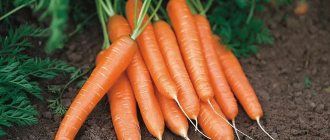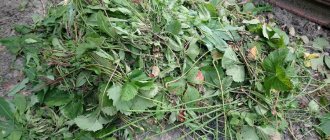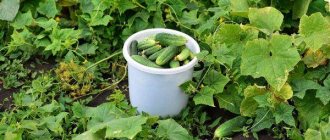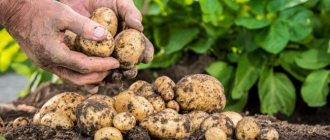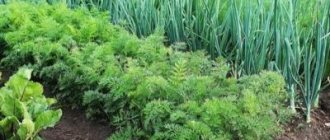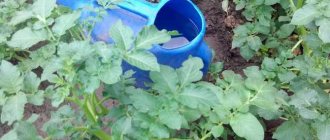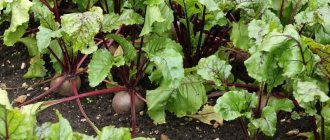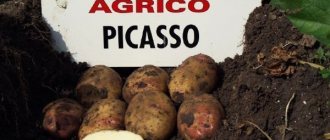Is it possible to plant potatoes after potatoes?
Potatoes can be planted in the same area after 3-4 years. If the area is small, then it can grow in one place, but not more than 3 years.
At the same time, organic and mineral fertilizers are introduced into the soil, compensating for all the beneficial substances taken from the soil by potatoes. In addition, we must not forget about soil disinfection, since diseases and pests will attack potatoes with renewed vigor every year.
After harvesting the potato crop, the soil is dug deep and the layer is completely turned over. This helps to freeze the ground and destroy diseases and pests.
In the spring, after the soil has warmed up, compost or humus is added and it is dug up again. Mineral fertilizers are applied during planting.
After harvesting early potatoes, green manure is sown in its place; they will improve the soil for subsequent plantings.
How will greening help?
Space in the garden is limited. Several hundred kilograms of potatoes are required. It is necessary to restore soil fertility, improve its health, and get rid of pests as soon as possible.
The problem should be solved with the help of green manure. The potato harvest is harvested in late summer or early autumn. There is enough time to grow oats, rye, rapeseed, mustard, and peas in the freed area.
See also
How to deal with black leg on potatoes?Read
You need to wait until it grows to 10–15 cm, then dig it up with green mass. This technique will enrich the soil with nitrogen. Oats and rye will get rid of wireworm larvae.
In order for the soil to recover better, some gardeners leave cereals to overwinter under the snow. The ridges are dug up in the spring. In this case, it is important to prevent the green mass from overgrowing: cultivated plants become weeds.
What to plant after potatoes next year?
When choosing crops that can grow after potatoes, we must not forget about the rules of crop rotation.
According to the rules of rotation, crops are divided into 4 groups:
- Root vegetables (potatoes, onions, beets, carrots). Producing a good harvest with a high potassium content in the soil.
- Fruits (cucumbers, pumpkin, peppers, eggplants, zucchini). Demanding on the presence of phosphorus in the soil.
- Leafy (greens, cabbage, lettuce, spinach). Demanding on nitrogen content in the soil.
- Legumes that saturate the soil with nitrogen. Most suitable for crop rotation.
Any crops are planted in accordance with their needs for nutrients, for example, leafy plants are planted after legumes. And legumes, in turn, grow well after onions and garlic. And they give a good harvest after potatoes.
Vegetable crop rotation table
| Potato | Onion garlic | Legumes | Peppers, eggplants, tomatoes | Cucumbers, zucchini | Carrot | Beet | Cabbage |
| Onion garlic | Legumes | Peppers, eggplants, tomatoes | Cucumbers, zucchini | Carrot | Beet | Cabbage | Potato |
| Legumes | Peppers, eggplants, tomatoes | Cucumbers, zucchini | Carrot | Beet | Cabbage | Potato | Onion garlic |
| Peppers, eggplants, tomatoes | Cucumbers, zucchini | Carrot | Beet | Cabbage | Potato | Onion garlic | Legumes |
| Cucumbers, zucchini | Carrot | Beet | Cabbage | Potato | Onion garlic | Legumes | Peppers, eggplants, tomatoes |
| Carrot | Beet | Cabbage | Potato | Onion garlic | Legumes | Peppers, eggplants, tomatoes | Cucumbers, zucchini |
| Beet | Cabbage | Potato | Onion garlic | Legumes | Peppers, eggplants, tomatoes | Cucumbers, zucchini | Carrot |
| Cabbage | Potato | Onion garlic | Legumes | Peppers, eggplants, tomatoes | Cucumbers, zucchini | Carrot | Beet |
Can onions, strawberries, cucumbers, tomatoes, and cabbage be planted after potatoes?
During crop rotation, you can alternate tops and roots, for example, in place of potatoes and tomatoes, greens, legumes, carrots, beets, lettuce, garlic, zucchini, cucumbers, cabbage and pumpkin are planted.
In the spring, former potato beds can be planted with: onions, radishes, garlic, radishes, spinach, beets, lettuce, turnips, cabbage, daikon, cucumbers, zucchini, pumpkin, legumes and melons.
In place of onions, garlic, legumes, you can sow and plant any crops. Planting them again in one place is undesirable.
It is not recommended to plant strawberries and wild strawberries in place of potatoes.
In place of melons, zucchini, squash, and cucumbers, the following grow well: potatoes, legumes, radishes, tomatoes, garlic, onions and cabbage.
Instead of tomatoes or cabbage, carrots are grown.
What to plant in the fall?
In the fall, after harvesting potatoes, you can sow greens, winter grains, and peas. All these crops allow the restoration of deep layers of soil and grow well in the place of potatoes.
Before winter
To improve the soil composition, you can sow green manure:
- alfalfa
- oats
- lupine
- rape
- mustard
- peas
- phacelia
They not only improve the composition of the soil, but also loosen it and fight diseases and pests.
From the wireworm
The larvae of the click beetle (wireworms) are distributed everywhere, not only in potato beds.
It is not advisable to control pests with pesticides. Toxic substances then enter the plants. In addition, they destroy not only larvae, but also living organisms useful to the soil.
Therefore, various agrotechnical control methods are more often used. Digging the soil in the fall reduces the number of insects. The larvae die from the cold.
- Early spring digging also helps in the fight against wireworms.
- Properly organized crop rotation helps get rid of wireworms.
- In heavily infested areas, green manure is sown after harvesting.
- The wireworm does not like crops such as: buckwheat, mustard, rapeseed, rapeseed, sweet clover, oilseed radish, black beans, chickpeas, beans, soybeans, peas, soybeans and spinach.
These crops are sown on the site for 2-3 years. During this period, all wireworm larvae die or turn into beetles and leave.
Sown green manure attracts pests, after which the plants are dug up and removed from the site.
Marigolds and white mustard, sown between the rows or along the edges of the beds, will also help fight wireworms.
Instead of pesticides, ammonia fertilizers are applied to the soil in the spring, which destroy the pest.
Green manure and onions after potatoes: video
Companion plants for potatoes
Sometimes the proximity of different crops in the beds turns out to be very useful. Proper selection of companion plants helps them grow together and protect them from pests.
For potatoes, experts have developed the following recommendations.
| Potato variety | Companion plant | |
| Good companion | Bad companion | |
| For all varieties |
|
|
Anastasia Lebedeva, Candidate of Agricultural Sciences, advises planting potatoes, radishes and daikon or radishes together.
She makes the following recommendations for varieties:
- radish – Winter round black, Chernavka;
- daikon - Sasha, Dubinushka, Elephant's Tooth;
- Radish – Duro, Early Red, White Night.
The root crops grow full-bodied, do not crack, almost never shoot, and are stored well.
Let us explain the mechanism of interaction between potatoes and companions such as garlic and cucumber. The first of them prevents the development of a fungal disease, late blight, that is destructive for potatoes. Also, the composition of the nutrients required for it is very different from those needed for potatoes and therefore no negative effect on their joint growth is observed.
The picture is different with the cucumber; it is a bad companion. Cucumber not only does not slow down the growth of late blight spores, but also allows the fungus to use itself as a kind of “house”.
In addition to vegetable crops, good companions for potatoes are horseradish, planted in small quantities along the edges of the plot, as well as coriander, nasturtium, tansy and marigolds, which repel such a dangerous pest as the Colorado potato beetle.
Memo to the gardener: Which vegetables can be planted nearby and which ones cannot
After what crop should potatoes be planted?
The best predecessors for potatoes are various root vegetables, cabbage, and green crops.
You can alternate onions, beets, carrots, peas, zucchini, beans, cucumbers and beans with potatoes.
After strawberries, watermelons?
In place of strawberries and wild strawberries, you can plant potatoes and other root vegetables, legumes, next year you can plant zucchini, cucumbers, pumpkin, and then onions and tomatoes.
After watermelons, melons, celery, cucumbers, carrots and parsley, the following are planted: potatoes, tomatoes, legumes, onions and garlic.
Rules for preparing beds
After harvesting potatoes, the soil should be prepared. Simple measures will create optimal conditions for crops to grow and develop. Required:
- dig up the tubers completely (small, cut, diseased);
- remove and burn potato tops;
- dig up the soil using a spade bayonet and level it with a rake;
- sow green manure (with them the earth restores fertility and rests);
- wait until the height is 15 cm, dig and embed it in the ground.
Leave the beds for the winter. In the spring, when digging, add potassium and phosphorus. After all the activities, the selected crops are planted.
Some gardeners, due to limited space, return the potatoes to their original place after a year. Agronomists advise returning it no earlier than the third season: this will ensure the desired yield.
Why should you not plant potatoes?
During the growing season, potatoes take phosphorus and potassium from the soil. After harvesting, it is necessary to replenish the lack of these substances in the soil by introducing appropriate fertilizers.
Potatoes cannot be planted after tomatoes, peppers, eggplants, physalis and tobacco. They are related crops and have common pathogens and pests. At the same time, spores of late blight, macrosporiosis, various rots accumulate in the soil, and the plants begin to hurt.
What can't be planted after potatoes?
Potatoes as a predecessor are not suitable for strawberries. Strawberry beds in place of potatoes can grow no earlier than after 3 years.
It is strictly forbidden to grow potatoes in place of:
- sunflower,
- cucumbers,
- pumpkin,
- zucchini,
- squash,
- watermelons,
- melons,
- raspberries
Reasons for crop rotation
Experienced gardeners understand that crops grown in the garden must be moved so that the quality of the harvest does not decrease. This is called crop rotation. Not all vegetables produce the same yield after the same predecessors.
Each crop requires its own minerals and necessary elements, which it selects from the ground in order to grow quickly and develop as efficiently as possible. Each vegetable attracts its own distinctive pests and suffers from specific diseases. Therefore, alternation must be arranged in such a way that each subsequent plant draws out the components that are important for it from the soil, and the insects and pathogens remaining from its predecessors are not afraid of it.
In addition to properly organized crop rotation, you should regularly replenish the soil with minerals and organic matter, and protect plantings from pests and diseases. In the case of correct crop rotation, the need for such measures becomes minimal.
Recommendations for changing vegetable crops divide plants into 4 groups. All of them are characterized by their own characteristics:
- Leafy and green vegetables require a high nitrogen content in the soil.
- Fruit plants require phosphorus.
- For root crops, it is important that there is a lot of potassium in the fertile soil.
- All legumes are combined into a separate group. They supply the earth with nitrogen, so their cultivation is especially recommended for proper organization of crop rotation.
The best neighbors, what to plant nearby?
For the success of potato cultivation, you need to take into account the principles of healthy neighbors.
Potatoes go well with corn, white cabbage, beans, horseradish, spinach, mint, garlic and onions. They have a beneficial effect on potato plantings. Beans feed potatoes with nitrogen, protect them from the Colorado potato beetle, and it, in turn, protects it from the Bruchus pest.
Neighborhood with potatoes for cucumbers, zucchini, pumpkin, tomatoes, squash, peppers, physalis, eggplant and cabbage is undesirable for each other.
Planting strawberries and wild strawberries close to a potato bed attracts wireworms. In rainy weather, the berries are affected by black and gray rot. The infection eventually spreads to potato tubers.
Potato and strawberry plantings should be separated by strips of spinach, carrots, beets or radishes.
Potatoes also do not like proximity to cherries, apple trees, raspberries, sea buckthorn, chokeberries and grapes.
To prevent the appearance of onion flies, weevils, cabbage whites, as well as damage to plants by fusarium, marigolds can be planted between rows.
- Calendula protects against the Colorado potato beetle.
- Nasturtium prevents the appearance of whiteflies and whiteflies.
- Chamomile-pyrethrum does not allow aphids, cabbage cutworm caterpillars, white moths and rodents to approach.
- Tansy - from many pests.
- Lavender - from aphids, ants.
With the correct selection of neighboring crops, you can protect plants from diseases and pests and increase the yield.
What a useful neighborhood
To obtain a rich harvest, it is recommended to properly plant neighboring plants. This approach guarantees easier development of seedlings, increased growth and fruiting.
Many gardeners plant beans between rows of different vegetable crops. Beans ensure that the soil is enriched with nitrogen. At the same time, potatoes are able to protect legumes from bruchus.
To improve the quality of potatoes, it is recommended to plant marigolds, calendula, and nasturtium. Such flowers are planted around the perimeter of the garden or between rows of vegetables.
Potatoes also go well with onions, garlic, cabbage, corn, horseradish, spinach, eggplant and mint. If these crops grow nearby, the soil properties are improved and the ability to get rid of pests and prevent many diseases is guaranteed.
Tomatoes, sunflowers, and fruit trees (cherry, raspberry, cherry, rowan) should not be planted next to potatoes, as otherwise the risk of late blight infection will increase.
Soil and conditions for growing potatoes
This nightshade crop loves fertile, breathable, light soil, with a slightly acidic reaction, with a pH of 5-6.
Potatoes produce a good harvest on sandy, sod-podzolic, chernozem, peat, and gray forest soils.
Loose soil allows the root system to be saturated with oxygen and the tubers to develop well. Normal access of oxygen to the roots guarantees good taste of the tubers.
Damp areas and beds with close groundwater flow are not suitable for planting potatoes.
Over-watering potatoes is highly undesirable. This leads to slower plant growth and promotes the development of diseases. When groundwater passes close, a drainage system is required.
- Heavy sandy, clayey, podzolic soils require preliminary improvement.
- In dense soil, small, deformed and tasteless tubers are formed.
- A bucket of humus (compost, peat) is added per square meter to heavy clay, loamy soil. A bucket of clay soil is brought into a sandy or sandy loam area.
- In peat soil you need to add a bucket of compost or humus, a bucket of clay, a bucket of coarse sand.
- If the soil is highly acidic, slaked lime or ash is added.
Fertilizing, watering, weeding and hilling potatoes can compensate for the lack of oxygen and nutrients, which allows you to grow a good harvest.
Shaded areas are not suitable for growing potatoes. The beds should be light, fully heated by the sun's rays. Lack of light leads to elongated, lightened stems, poor flowering, and poor and small harvests.
Plowing or digging the soil for potatoes creates a loose, aerated layer of soil with a sufficient amount of moisture.
Potatoes are planted in an area dug up in advance, in the fall, to a depth of 25-30 centimeters.
Before digging begins, 5 kilograms of rotted manure or compost are added per square meter of land. On sandy or depleted soils, the amount of organic matter increases to 9 kilograms. Fresh manure and unripened compost are not suitable for these purposes.
- Along with organic matter, 200 grams of wood ash or slaked lime, 25 grams of potassium sulfate and 25 grams of double granulated superphosphate are added per square meter of beds.
- In the absence of organic matter, mineral fertilizers are buried in the soil. Per square meter of future plantings, 50 grams of ammonium sulfate, 15 grams of urea or 50 grams of superphosphate are used.
- Intensive potassium-phosphorus nutrition increases potato resistance to low temperatures and diseases, and helps increase yield.
All fertilizers are buried 12-15 centimeters into the ground.
1/2 of the norm of nitrogen fertilizers is applied in the spring, after plowing, and covered with a rake. The second part of the fertilizer is applied before hilling the potatoes.
Potatoes propagate vegetatively. To do this, take whole or cut in half healthy large tubers. The future harvest depends on the size of the tubers and the number of eyes on them. It is not possible to harvest a large harvest from small potatoes with a small number of eyes.
Tubers are prepared in the fall. They are selected and sent for storage in a well-ventilated area. Tubers are germinated 1-2 months before planting. To do this, they are distributed in a thin layer in boxes and placed in a bright room at an air temperature of +15-20 degrees.
After germination, tubers with thread-like sprouts are removed.
It is better to plant potatoes from north to south or from northwest to southeast. The optimal soil temperature for planting potatoes is +7-8° degrees.
For early potatoes, add a glass of humus, a tablespoon of ash and a teaspoon of superphosphate to each hole. The mixture is embedded in the soil to a depth of 10 centimeters. For mid-season varieties, the amount of fertilizing is increased twice and deepened by 15 centimeters.
The potatoes are laid out in holes and sprinkled with soil, and tubercles are formed on top of the holes. If the air temperature has not reached the required standards, the plantings are covered with film or non-woven material. When shoots appear, arcs are installed. In persistent warm weather, the shelter is removed.
General information about culture
Potatoes belong to the Solanaceae family. This is a perennial plant that is cultivated as an annual. The tubers of the crop are eaten, while its fruits are poisonous due to their high solanine content. Depending on the variety, the shrub can reach a height of up to one meter. The stem is usually bare and ribbed. The foliage of the plant is dark green and consists of a terminal lobe and several pairs of lateral lobes with intermediate lobes between them. The culture blooms with purple, white or pink flowers, which are collected in a shield at the very top of the stem.
Potato tubers are not essentially fruits, but swollen buds consisting entirely of thin-walled faceted cells. Their outer part (peel) is a thin-walled cork fabric. Potato tubers ripen in August or September, depending on whether the particular variety is early, mid or late ripening.
Potatoes are propagated vegetatively - through tubers, tuber parts or seeds. The latter are used exclusively for selective purposes. Tubers are planted in open ground to a depth of 5-10 centimeters.
Potatoes grow best in gray forest, soddy-podzolic soils, as well as in black soil and drained peat bogs. A mandatory requirement for the soil is that it must be loose. If the soil is dense, the tubers will form small and deformed.
The optimal fertilizers for potatoes, allowing you to grow a large crop, are bone meal, lime, and rotted manure.
Important! Excess nitrogen fertilizers in the case of potatoes is undesirable. Such fertilizing promotes abundant growth of the fight and slows down the formation and growth of tubers.
During flowering and tuberization, it is especially important to water the potatoes abundantly. However, one should not forget that excess moisture causes irreparable harm to the crop. If water stagnates in the soil, the plant can rot and even die.
For relaxation and healing of the plantation
Cultivated sedirats are the best alternative for soil self-healing. The balance of useful elements and the activity of necessary microorganisms will be restored by honey-bearing sweet clover, alfalfa, phacelia and clover, fodder vetch, and medicinal sainfoin. Monoculture, or even better - a mixture. It will fertilize the garden bed better than store-bought manure. Sowing winter crops will help: rye, oats, rapeseed.
Note! You should wait two weeks after harvesting the tubers, then remove all the tops, level the area with a rake, and, after making furrows, sow the grains. The green shoots will already disappear under the snow. In the spring you will need to dig up the soil, renewed and ready for new harvests.
If it is not possible to grow useful perennials or sow grains, then according to the rules of crop rotation the next year after potatoes, you can plant mustard, which has the ability to not only absorb, but also release nitrogen to the soil (it will also provide reliable protection against wireworms), oilseed radish or legumes :
- peas;
- lentils;
- chickpeas;
- beans;
- common peanut.
The next season after potatoes, it is necessary and possible to plant spinach, radishes, celery, radishes, assorted salads, disinfecting garlic and onions - they will optimally saturate, loosen and enrich the soil. Beets and carrots will do.
Symbiosis and beneficial neighborhood
Experienced gardeners, in addition to alternating interchangeable crops, use mixed planting of potatoes and “symbionts” - favorably combined plants. Mixed cultivation helps:
- optimal use of fertile reserves;
- increase productivity and the amount of macro- and micronutrients;
- fight pests and pathogens;
- optimize the absorption of top dressing and fertilizers;
- minimize the accumulation of biochemical excesses in the soil - microtoxins.
Between the rows, so that the soil does not become empty - for compaction, radishes, rutabaga, radishes, onions and bush beans are planted (the last two partners can be thrown directly into the hole, but legumes, like asparagus, should be planted along the edges of the plantation). “Second bread” protects neighbors from bruchus, onion flies, powdery mildew, they protect it from malicious pests, including wireworms, nutcracker beetles, aphids and the “Colorado predator”, and even share nitrogen. Beets and carrots fit well in the furrow. Along the paths (in the form of a border) there is corn. Spinach, coriander, chard, white and black mustard - in a wide gap between the bushes, and horseradish can also be added along the perimeter of the plantings. These are the best leavening agents and phytosanitary agents that protect against fusarium and late blight.
All pumpkins, from cucumbers to melons, peacefully coexist side by side (the main thing is that the tendrils do not creep onto the tops). Protected from slugs, various types of cabbage get along well: white, red, kohlrabi, Brussels sprouts...
Spicy basil will not hurt, it will disorient the visiting Colorado potato beetles. The ubiquitous dill is considered neutral.
How to get rid of the Colorado potato beetle on potatoes: the best preparations and the most effective remedies The Colorado potato beetle is an insect that quickly gets used to unfavorable living conditions. Bad years or...
But if petiole or root celery, ordinary or curly parsley grows nearby, the potatoes will develop poorly. Apple, sea buckthorn, cherry, raspberry, and chokeberry are considered mutually burning “enemies.” The potatoes are shredded, fruits and berries become tasteless. A sunflower growing in the same place will draw out all the juices, size and flavor from the potato.
Further you need to retreat from remontant strawberries, wild and garden strawberries - all kinds of pests and diseases will come running at once.
Excellent travel companions, neutralizers and guards are flowers and herbs planted around potato fields or between them and intractable neighbors:
The best predecessors for potatoes
In crop rotation in the garden, potatoes have a fairly large list of suitable predecessors.
Leafy vegetables and greens
In the group of greens and leafy crops grown before potatoes, the following plants are distinguished:
- lettuce and spinach - improve the beneficial microflora of the soil;
- mustard - enriches the soil with phosphorus, inhibits weeds;
- horseradish and coriander - inhibit fungal spores in the soil;
- nettle - saturates the soil with iron;
- parsley, basil, marjoram, thyme - insect repellents.
Legumes
Leguminous plants have a beneficial property for the soil: they enrich the soil with useful elements and loosen it. Peas, soybeans, beans - these crops leave a supply of nitrogen, phosphorus and potassium in the soil.
Important! Forage cereals have a tap root system that loosens the soil, improving its water and air permeability. After mowing, the straw of these grasses is incorporated into the soil as fertilizer before cultural planting. The same restorative function is performed by perennial grasses of the legume family:
The same restorative function is performed by perennial grasses of the legume family:
- alfalfa;
- vetch (spring and winter);
- sainfoin;
- seradella;
- sweet clover
Roots
Beetroot and root celery are considered light crops, after which you can plant any vegetables, including tuberous ones. Carrots, radishes, radishes are plants that are undemanding in terms of nutrition, therefore they do little to deplete the soil.
Did you know? Despite the fact that South America is considered the birthplace of potatoes, neighboring North America became acquainted with the crop half a century later than Europe. The governor of Bermuda sent the vegetable as a gift to the governor of the US state of Virginia.
Fruit, berry and grain plants
Suitable for previous plantings are early vegetables, such as:
- zucchini;
- zucchini;
- Pattison.
Crops practically do not attract insects to the beds
- Cereal plants that are useful for subsequent planting of tubers are:
- oats;
- rye;
- barley.
Firstly, this is a completely different group, a different family, there are no common diseases or pests with potatoes. Secondly, green manure saturates the soil with essential minerals and attracts beneficial insects. Grains inhibit the growth of weeds, improve soil structure and the activity of beneficial microflora.
Important! Strawberries and nightshade crops have common insect pests; the circulation of these plants in the garden is contraindicated.
Strawberries and raspberries are frankly bad predecessors. Both berries “suck” maximum nutrients from the soil. Sweet fruits attract slugs, various types of flies and subsoil pests: mole crickets, wireworms.
What is crop rotation
Growing the same crop in a permanent place for several years in a row leads to adverse consequences. Over time, the soil begins to deplete and accumulate pests and plant pathogens. To avoid this, you need to follow the rules of crop rotation and plant crops in other beds the next season.
Crop rotation is the scientifically based alternation of crops within a territory and over time.
There are several good reasons why it is necessary to comply with it:
- reducing the level of soil contamination by pests, diseases and weeds;
- improving the structure of the topsoil;
- saturating the soil with essential nutrients.
Some types of plants receive nutritional components from the lower layers of the soil, others from the upper layers. Planting different crops in the same place every year will ensure healthier soil and more rational use of nutrients.
